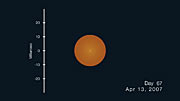Tisková zpráva
„Nová hvězda“ zaprášila vesmír
Přístroj VLTI poprvé pozoroval formování prachu okolo explodující hvězdy
24. července 2008
Díky jedinečně bystrému pohledu interferometru na VLT/ESO mohli být prvně astronomové svědky vzniku prachoplynného obalu okolo explodující hvězdy. Vývoj tohoto obalu pozorovali celých 100 dní a získali zcela nový způsob, jak odhadnout jeho vzdálenost a nasbírat nedocenitelné informace o tzv. hvězdném kanibalismu, tj. přelévání hmoty hvězdy na jejího hmotnějšího hvězdného průvodce.
Novy byly zprvu považovány za nové hvězdy, které se nečekaně objevily na obloze. Odtud pochází i jejich latinské označení nova. Ve skutečnosti dnes víme, že jde o krátkodobé zjasnění malé hmotné hvězdy, která se nachází ve dvojhvězdném systému. Jednu jeho složku tvoří bílý trpaslík (závěrečná fáze vývoje hvězdy podobné Slunci) a druhou je nejčastěji málo hmotná hvězda hlavní posloupnosti, např. červený trpaslík. Tyto dvě hvězdy jsou natolik blízko u sebe, že červený trpaslík ztrácí část své hmoty ve prospěch svého průvodce. Příležitostně se obálka hmoty, jež padá na těžší hvězdu, stává nestabilní, což vede k termonukleární explozi. Tím systém dočasně zjasňuje.
Nova Scorpii 2007a (též známa jako V1280 Scorpii) byla poprvé objevena japonským amatérským astronomem 4. února 2007 a nachází se v souhvězdí Štíra. Po několik dní neustále zjasňovala až 17 února dosáhla svého maxima. Stala se jednou z nejjasnějších nov za posledních 35 let. Byla pozorovatelná i neozbrojenýma očima.
Jedenáct dní po svém maximu byli astronomové svědky zformování prachu okolo hvězdy. Prach byl pozorovatelný po více jak 200 dní a v jeho středu se od října do listopadu 2007 pomalu vynořovala hvězda. Během těchto 200 dní byl zdroj výrazně zastíněn a jeho jasnost poklesla ve viditelném optickém oboru více jak 10000 krát.
Pozorovací program přesáhl dobu pěti měsíců od objevení novy a za pomoci interferometru VLTI bylo dosaženo nebývalé rozlišovací schopnosti. Astronomové zprvu použili zařízení AMBER pro blízkou infračervenou oblast a později, jak nova okolo sebe produkovala prach, využili zařízení MIDI, které je na záření horkého prachu více citlivé. Obdobně, jak nova slábla, přešli od 1,8 m dalekohledů (Auxiliary Telescopes ) k jejich větším kolegům o průměru 8,2 m (Unit Telescopes). Spojením jednotlivých dalekohledů v jeden obří interferometr bylo dosaženo stejné rozlišovací schopnosti, jako by byl použit objektiv o průměru mezi 35 až 71 metrů (vzdálenost mezi dvěma použitými dalekohledy).
První pozorování pokrylo 23 dní od objevu novy a ukázalo, že jedná a velmi kompaktní zdroj o průměru jedné tisíciny úhlové vteřiny (1 miliarcsekunda či mas). Jde o velikost srovnatelnou s průměrem písečného zrnka pozorovaného ze vzdálenosti 100 km. O několik dní později, po zaznamenání hlavní fáze tvorby prachu, měl zdroj již 13 mas.
„Je velmi pravděpodobné, že pozdější velikost odpovídá průměru expandujícího prachového obalu, zatímco první měření určují maximální velikost explodujícího zdroje,“ vysvětluje hlavní autor práce Olivier Chesneau. Během následujících měsíců se obálka rovnoměrně zvětšovala rychlostí 2 milióny kilometrů za hodinu.
„Je to poprvé, co jsme mohli prozkoumat prostorové rozložení prachového obalu novy a zaznamenali jeho vývoj od samého počátku až do okamžiku, kdy jeho jasnost poklesna na hranici pozorovatelnosti,“ říká spoluautor práce Dipankar Banerjee z Indie.
Z měření úhlové rychlosti rozpínání objektu a znalosti rychlosti rozpínání umožnilo astronomům odvodit jeho vzdálenost, jež určili na 5500 světelných let.
„Jde o novou slibnou metodu určování vzdáleností u blízkých nov. Umožnili ji jednak nemodernější přístroje VLTI, ale také kvalitní management pozorování, díky kterému bylo možné takovýto pozorovací program připravit,“ říká spoluautor Markus Wittkowski z ESO.
Navíc kvalita dat, kterou VLTI poskytl, umožnila odhadnout denní produkci prachu a odvodit celkové množství vyvržené hmoty. „Celkově V1280 vyvrhla hmotu odpovídající 33 násobku hmotnosti Země. Jde o obdivuhodný výkon uvážíme-li, že velikost hvězdy byla srovnatelná se Zemí,“ dodává Chesneau. Pouze jedno procento z tohoto materiálu bylo ve formě prachu.
Další informace
Článek VLTI monitoring of the dust formation event of the Nova V1280 Sco od O. Chesneau a kol. zveřejněný ve vědeckém časopise Astronomy and Astrophysics.
The team is composed of O. Chesneau, S. Sacuto, and A. Spang (CNRS/OCA, Grasse, France), D. P. K. Banerjee, N. M. Ashok and R. K. Das, (Physical Research Laboratory, Gujarat, India), F. Millour, N. Nardetto and S. Kraus (Max-Planck-Institut für Radioastronomie, Bonn, Germany), E. Lagadec (Department of Physics and Astronomy University of Manchester, UK), and M. Wittkowski, C. Hummel, M. Petr-Gotzens, S. Morel, F. Rantakyro, and M. Schöller (ESO).
A French press release is available at http://fizeau.unice.fr/article.php3?id_article=189
Kontakty
Olivier Chesneau
Observatoire de la Côte d'Azur
Grasse, Côte d'Azur
Tel.: +33 4 93 40 53 40
Email: Olivier.Chesneau@obs-azur.fr
Markus Wittkowski
ESO
Garching, Germany
Tel.: +49 89 3200 6769
Email: mwittkow@eso.org
Dipankar Banerjee
Physical Research Laboratory
Ahmedabad, India
Tel.: +91 79 26314611
Email: orion@prl.res.in
Anežka Srbljanović (press contact Česko)
ESO Science Outreach Network
a Astronomical Institute of Czech Academy of Sciences
Tel.: +420 323 620 116
Email: eson-czech@eso.org
O zprávě
| Tiskové zpráva č.: | eso0822cs |
| Legacy ID: | PR 22/08 |
| Jméno: | Nova Scorpii 2007a, V1280 Scorpii |
| Typ: | Local Universe : Star : Evolutionary Stage : Supernova |
| Facility: | Very Large Telescope, Very Large Telescope Interferometer |
| Instruments: | AMBER, MIDI |
| Science data: | 2008A&A...487..223C |
Our use of Cookies
We use cookies that are essential for accessing our websites and using our services. We also use cookies to analyse, measure and improve our websites’ performance, to enable content sharing via social media and to display media content hosted on third-party platforms.
ESO Cookies Policy
The European Organisation for Astronomical Research in the Southern Hemisphere (ESO) is the pre-eminent intergovernmental science and technology organisation in astronomy. It carries out an ambitious programme focused on the design, construction and operation of powerful ground-based observing facilities for astronomy.
This Cookies Policy is intended to provide clarity by outlining the cookies used on the ESO public websites, their functions, the options you have for controlling them, and the ways you can contact us for additional details.
What are cookies?
Cookies are small pieces of data stored on your device by websites you visit. They serve various purposes, such as remembering login credentials and preferences and enhance your browsing experience.
Categories of cookies we use
Essential cookies (always active): These cookies are strictly necessary for the proper functioning of our website. Without these cookies, the website cannot operate correctly, and certain services, such as logging in or accessing secure areas, may not be available; because they are essential for the website’s operation, they cannot be disabled.
Functional Cookies: These cookies enhance your browsing experience by enabling additional features and personalization, such as remembering your preferences and settings. While not strictly necessary for the website to function, they improve usability and convenience; these cookies are only placed if you provide your consent.
Analytics cookies: These cookies collect information about how visitors interact with our website, such as which pages are visited most often and how users navigate the site. This data helps us improve website performance, optimize content, and enhance the user experience; these cookies are only placed if you provide your consent. We use the following analytics cookies.
Matomo Cookies:
This website uses Matomo (formerly Piwik), an open source software which enables the statistical analysis of website visits. Matomo uses cookies (text files) which are saved on your computer and which allow us to analyze how you use our website. The website user information generated by the cookies will only be saved on the servers of our IT Department. We use this information to analyze www.eso.org visits and to prepare reports on website activities. These data will not be disclosed to third parties.
On behalf of ESO, Matomo will use this information for the purpose of evaluating your use of the website, compiling reports on website activity and providing other services relating to website activity and internet usage.
Matomo cookies settings:
Additional Third-party cookies on ESO websites: some of our pages display content from external providers, e.g. YouTube.
Such third-party services are outside of ESO control and may, at any time, change their terms of service, use of cookies, etc.
YouTube: Some videos on the ESO website are embedded from ESO’s official YouTube channel. We have enabled YouTube’s privacy-enhanced mode, meaning that no cookies are set unless the user actively clicks on the video to play it. Additionally, in this mode, YouTube does not store any personally identifiable cookie data for embedded video playbacks. For more details, please refer to YouTube’s embedding videos information page.
Cookies can also be classified based on the following elements.
Regarding the domain, there are:
- First-party cookies, set by the website you are currently visiting. They are stored by the same domain that you are browsing and are used to enhance your experience on that site;
- Third-party cookies, set by a domain other than the one you are currently visiting.
As for their duration, cookies can be:
- Browser-session cookies, which are deleted when the user closes the browser;
- Stored cookies, which stay on the user's device for a predetermined period of time.
How to manage cookies
Cookie settings: You can modify your cookie choices for the ESO webpages at any time by clicking on the link Cookie settings at the bottom of any page.
In your browser: If you wish to delete cookies or instruct your browser to delete or block cookies by default, please visit the help pages of your browser:
Please be aware that if you delete or decline cookies, certain functionalities of our website may be not be available and your browsing experience may be affected.
You can set most browsers to prevent any cookies being placed on your device, but you may then have to manually adjust some preferences every time you visit a site/page. And some services and functionalities may not work properly at all (e.g. profile logging-in, shop check out).
Updates to the ESO Cookies Policy
The ESO Cookies Policy may be subject to future updates, which will be made available on this page.
Additional information
For any queries related to cookies, please contact: pdprATesoDOTorg.
As ESO public webpages are managed by our Department of Communication, your questions will be dealt with the support of the said Department.


